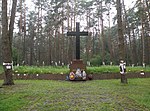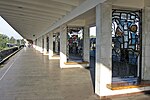Desnianskyi District, Kyiv

Desnianskyi District (Ukrainian: Деснянський район, translit. Desnians’kyi raion) is an administrative raion (district or borough) of the city of Kyiv, the capital of Ukraine. It is located in the north-eastern part of the city on the Left Bank of the Dnieper River and is the most populous district of Kyiv. It is also the second largest district, with the total area of ca. 14.2 ha. Desnianskyi District mainly consists of two microdistricts – Troieshchyna and Lisovyi – making it predominantly residential in nature. There is only one clear-cut, (yet small) industrial zone called Kulykove on the border with Dniprovskyi Raion. This fact explains why the district has the lowest number of registered business entities among Kyiv raions. Much like commuter town, therefore, Desnianskyi District has very little commercial or industrial activity beyond a small amount of retail, oriented toward serving the locals. However, it differs from commuter towns in that it forms part of the city proper and is not regarded as suburb in a classical sense. Still, its currently weak transportation links with the major part of the city on the Right Bank make it appear as a "city inside a city", which is especially true for Troieshchyna microdistrict.
Excerpt from the Wikipedia article Desnianskyi District, Kyiv (License: CC BY-SA 3.0, Authors, Images).Desnianskyi District, Kyiv
О-100603, Kyiv
Geographical coordinates (GPS) Address Nearby Places Show on map
Geographical coordinates (GPS)
| Latitude | Longitude |
|---|---|
| N 50.53 ° | E 30.704166666667 ° |
Address
О-100603
07415 Kyiv
Ukraine
Open on Google Maps










